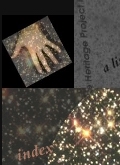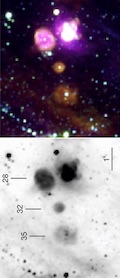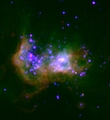



Calibration of nebular emission-line diagnostics: II. Abundances
M.S. Oey and J.C. ShieldsWe examine standard methods of measuring nebular chemical abundances, including estimates based on direct T_e measurements, and also emission-line diagnostics. We use observations of the LMC H II regions DEM L199, DEM L243, DEM L301, and DEM L323, whose ionizing stars have classifications ranging from O7 to WN3. Following common practice, we assume a two-zone T_e structure given by T(O^{++}) and T(O^+) to compute ionic abundances. We compare with photoionization models tailored to the observed properties of the individual objects, and emphasize the importance of correctly relating T_e in the two zones, which can otherwise cause errors of ~0.2 dex in abundance estimates. The data show no spatial variations or local metallicity enhancements to within 0.1 -- 0.15 dex in any of the objects, notably including DEM L199, which hosts three WR stars. Our data agree well with both the modeled R23 and S23 abundance diagnostics for O and S. We present the first theoretical tracks for S23, which are in excellent agreement with a larger available dataset. However, contrary to earlier suggestions, S23 is much more sensitive to the ionization parameter (U) than is R23. This occurs because S23 does not sample [S IV], which is often a significant population. We therefore introduce S234=([S II]+[S III]+[S IV])/H-beta and demonstrate that it is virtually independent of U. Predicted and observed spatial variations in S234 are thus dramatically decreased in contrast to S23. The intensity of [S IV]10.5 microns can be easily estimated from the simple correspondence between [S IV]/[S III] and [O III]/[O II]. Using this method to estimate S234 for data in the literature yields excellent agreement with our model tracks, hence we give a theoretical calibration for S234. Our models show that the double-valued structure of S23 and S234 remains an important problem as for R23, and presently we consider calibrations of these S diagnostics reliable only at Z ~< 0.5 Z_sol. However, the slightly larger dynamic range and excellent compatibility with theoretical predictions suggest the S parameters to be more effective abundance diagnostics than R23. ApJ, 539, 687
|

